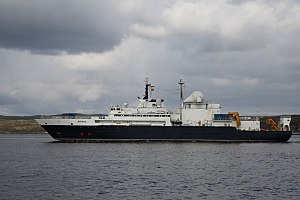Russian research vessel Yantar

| |
| History | |
|---|---|
| Name | Yantar |
| Builder | Yantar Shipyard |
| Yard number | 01602 |
| Laid down | 8 July 2010 |
| Launched | 5 December 2012 |
| Commissioned | 23 May 2015 |
| Identification |
|
| Status | In service |
| General characteristics [1] | |
| Class and type | Template:Sclass2- |
| Displacement | 5,736 tons (full load) |
| Length | 107.8 m (354 ft) |
| Beam | 17.2 m (56 ft) |
| Installed power |
|
| Propulsion |
|
| Speed | 15 kn (28 km/h; 17 mph) |
| Range | 8,000 nmi (15,000 km; 9,200 mi) |
| Endurance | 60 days |
| Boats & landing craft carried |
|
| Complement | 60 |
| Aviation facilities | Helipad for 1 helicopter |
Yantar (Янтарь) is a special purpose intelligence collection ship built for the Russian Navy.[2] The ship has been operated by the Russian Navy's Main Directorate of Underwater Research (GUGI) since 2015 and is reportedly a spy ship.[2][3] The vessel's home port is Severomorsk, where it is attached to the Northern Fleet.[4] A sister Project 22010-class ship "Almaz" is also under construction.[3]
Design and construction
Yantar was designed by the CMDB Almaz Design Bureau in St. Petersburg, and the hull was laid down on 8 July 2010.[5] It was launched in December 2012, and concluded its sea trials in May 2015. The ship has a length of 108 metres (354 ft) and a full displacement of 5,736 tons. It uses diesel-electric propulsion for a top speed of approximately 15 knots (28 km/h; 17 mph). It officially has a complement of 60. The ship was built at the Yantar Shipyard in Kaliningrad.[5]
Roles
Yantar can act as a mothership to mini-subs. The United States Navy has stated that the submersibles are able to sever cables miles beneath the ocean's surface.[6][2] The submersibles are reportedly capable of operating at depths of up to 6,000 metres (20,000 ft). The submersibles are reportedly the project 16810 Rus-class submersible[5] and the project 16811 Template:Sclass-.[3]
According to Alexei Burilichev, head of the Russian Defense Ministry's deepwater research department, Yantar is an oceanic research complex.[6]
Activities
Yantar has been reported in position near undersea telecommunications cables.[2][6][3]
In 2015, Yantar was spotted off the coast of Guantánamo Bay, Cuba.[2][6]
Summer 2016, Yantar was anchored outside the Nuuk, Greenland.[7]
In 2017, Yantar was active in the eastern Mediterranean, near an undersea cable linking Israel to Cyprus.[2][3] It was also reportedly used to recover "secret equipment" from crashed Su-33 and MiG-29 aircraft.[3]
On 23 November 2017, upon an order of Russian President Vladimir Putin, Yantar and the specialists of the Russian Navy's 328th expedition search and rescue unit were sent to Argentina's coast to search for the Argentine submarine ARA San Juan that went missing on 15 November 2017.[8][3]
References
- ^ "Oceanographic research vessel Project 22010 Kruys". russianships.info. Retrieved 24 November 2017.
- ^ a b c d e f Mizokami, Kyle (September 19, 2017). "What Is a Russian Spy Ship Doing in the Eastern Mediterranean?". Popular Mechanics. Retrieved September 20, 2017.
- ^ a b c d e f g Peter, Laurence (3 January 2018). "What makes Russia's new spy ship Yantar special?". BBC News. Retrieved 3 January 2018.
- ^ Nilsen, Thomas (October 30, 2015). "Northern fleet gets unique vessel". The Barents Observer.
Northern fleet Commandor Admiral Vladimir Korolev said in his speech while welcoming the vessel to Severomorsk that "Yantar" will help raise hydrographic and research activities in the Oceans to a new quality level.
{{cite news}}: Italic or bold markup not allowed in:|publisher=(help) - ^ a b c "Project 22010 Kruys / Yantar Oceanographic research vessel". GlobalSecurity.org. Archived from the original on June 13, 2016.
{{cite news}}: Unknown parameter|deadurl=ignored (|url-status=suggested) (help) - ^ a b c d Sanger, David E.; Schmitt, Eric (October 26, 2015). "Russian Ships Near Data Cables Are Too Close for U.S. Comfort". The New York Times.
- ^ Krog, Anders. "Russisk spionskib ud for Nuuk". Artisknyt.dk (in Danish). Retrieved 1 December 2017.
I sommeren 2016 lå det russiske spionskib Yantar for anker få hundrede meter fra havnen i Grønlands hovedstad Nuuk.
- ^ "Russia sends Navy experts to search for missing Argentine submarine". TASS. 23 November 2017. Retrieved 24 November 2017.
